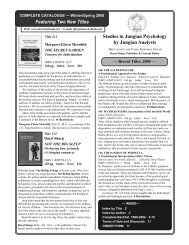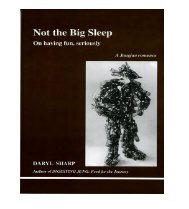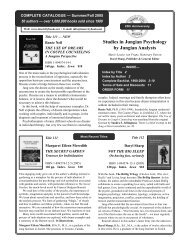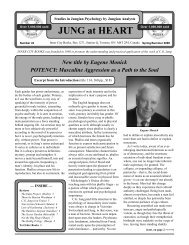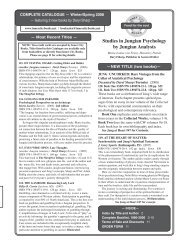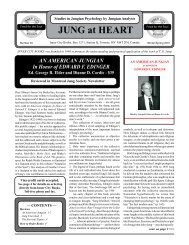Personality types: Jung's model of typology - Inner City Books
Personality types: Jung's model of typology - Inner City Books
Personality types: Jung's model of typology - Inner City Books
- No tags were found...
Create successful ePaper yourself
Turn your PDF publications into a flip-book with our unique Google optimized e-Paper software.
Introduction to Jungian Typology 19The word "retarded" here simply means neglected or notwell developed. In fact only in extreme cases are the otherfunctions completely absent, and there is regularly a secondfunction (occasionally even a third) that is prominent enoughto exert a co-determining influence on consciousness.One can <strong>of</strong> course be conscious <strong>of</strong> the contents or productsassociated with each <strong>of</strong> the functions. For instance, I canknow what I'm thinking without having a primary thinkingfunction, and I can tell the difference between a table and abottle without having a superior sensation function. But wecan only speak <strong>of</strong> the "consciousness" <strong>of</strong> a function, accordingto Jung, "when its use is under the control <strong>of</strong> the will and,at the same time, its governing principle is the decisive onefor the orientation <strong>of</strong> consciousness":This absolute sovereignty always belongs, empirically, to onefunction alone, and can belong only to one function, becausethe equally independent intervention <strong>of</strong> another functionwould necessarily produce a different orientation which, partiallyat least, would contradict the first. But since it is a vitalcondition for the conscious process <strong>of</strong> adaptation always tohave clear and unambiguous aims, the presence <strong>of</strong> a secondfunction <strong>of</strong> equal power is naturally ruled out. This other function,therefore, can have only a secondary importance. . . . Itssecondary importance is due to the fact that it is not, like theprimary function . . . an absolutely reliable and decisive factor,but comes into play more as an auxiliary or complementaryfunction. 10In practice, the auxiliary function is always one whose nature,rational or irrational, is different from the primary function.For instance, feeling cannot be the secondary functionwhen thinking is dominant, and vice versa, because both arerational or judging functions:10 Ibid., par. 667.



